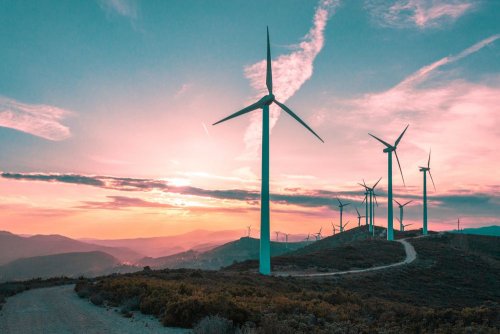The leaders of the world's leading economies have agreed on a "Green Marshall Plan" in the transition to clean energy to ensure a cleaner, greener, freer, fairer and more secure future for people and the planet.
To achieve this goal, the plan contains three key elements: the use of markets and scale, an open architecture approach, and leadership to avoid friction during decarbonization, said GMF.
They agreed on this at the G7 summit in Cornwall in 2021. The plan will require $100 billion in annual climate funding for all energy, carriers and fuels, including renewables and green hydrogen, in relevant sectors including transport, energy and industry, and for infrastructure, networks or measures such as energy efficiency.
The Paris Agreement defines the fight against climate change as a matter of common but differentiated responsibilities. Given much higher historical greenhouse gas emissions, rich countries are being called on to cut carbon emissions first and thus bear a larger share of the upfront costs. Developing countries, on the other hand, may decarbonize later in order to have some time to achieve economic development to a level where they can manage the transition.
However, there are risks that countries that do not make clean energy decisions early risk locking in carbon, and late decarbonization could lead to a growing competitive disadvantage.
As evidenced by current trends, investment is already alarmingly one-sided, pointing to the risks of maintaining uneven development trajectories in a decarbonizing global economy.
Using Markets
As the International Energy Agency notes, nearly half of the emission reductions needed in 2050 for net zero emissions come from technologies that are now at the prototype or demonstration stage.
To bring these clean technologies to market and apply them in time, innovation curves must be steeper than they have been so far. It's a matter of scale. Therefore, the development of huge markets in industrialized and newly industrialized countries is necessary in order to achieve the necessary economies of scale.
The transatlantic economic space will play an important, though not exclusive, role for the Marshall Plan for a clean energy transition. It is home to the world's leading low-carbon high-tech companies, holds the bulk of world-class patents in many sectors related to the energy transition, is highly integrated in trade relations, and accounts for about 40% of nominal global GDP.
Full use of the integrated transatlantic cleantech marketplace will accelerate innovation and make easer its path from demonstration to deployment, and reduce costs.
For this to happen, barriers need to be reduced, in particular the removal of EU and US tariffs on environmental goods and services, the establishment of common cleantech standards, and the harmonization of trade policies to promote an integrated transatlantic cleantech space.
The use of markets will mobilize the private capital needed to support the necessary investments in clean energy and will benefit the innovative capacity of companies and the private sector.
As countries gravitate toward technology leaders, one possible scenario is a clean-tech cold war between blocs led by the West and China, pushing the world away from international cooperation. Moreover, the geo-economic consequences of the war in Ukraine may well include an additional push towards global disengagement.
Open and inclusive approach
The plan requires the leadership of a dedicated core group of countries in the form of a transatlantic alliance. They will benefit economically from technological leadership, from the competitive advantage that comes from setting global standards, or from their companies gaining value from research and development to implementation.
The path to net zero must be open for developing countries to join the effort. The governance approach should be an "open architecture" that would offer different flexible entry points for non-core countries depending on their commitment and financial capacity.
The central tool here is access to an attractive and deep cleantech market. Another tool would be to stimulate more ambitious steps in the form of climate finance and targeted technology transfer.
It will need to expand significantly beyond the (currently unfilled) $100 billion annual fund, as well as focus on lowering capital spending and derisking clean energy projects in emerging economies to close the investment gap. Africa will be a key target region in this effort, given its demographic trends and strong economic growth potential, but a slow net investment record.
Leadership to avoid friction
Uneven transition patterns are unlikely to be completely avoided, as trajectory dependency may be too strong to ensure rapid changes in national energy systems, and temptations to stop the energy transition may arise given the scale of economic and lifestyle changes. The transatlantic alliance will play an important role in leading and managing the process.
Leadership should encompass competition, but should not be defined in terms of winning the green race, as this could lead to the world returning to great power competition.
In addition, transients are known for their unpredictable dynamics and are not linear. Therefore, management needs to accept the uncertainty associated with the transition from high to low carbon.
This may even extend to the petropowers, which eventually find themselves stripped of their existing economic model. Given the heavy dependency that underpins the oil economy, fossil fuel revenue streams will be difficult to replace in time to avoid rising social tensions. The current exporters of oil and gas can become a source of instability for their region and beyond.
The annual investment requirement for the energy transition is estimated at around 4.5% of global GDP by 2030.
In addition to combating climate change, the benefits for industrialized countries include new markets and avoiding a situation where one part of the world goes green and the rest is left without the finance and technological solutions needed to move towards a low-carbon future. The likely social impact on developing countries and the negative impact on international political stability could far outweigh the cost of their transition to clean energy.
As reported EcoPolicy before, G7 countries have identified timing of decarbonization energy.





